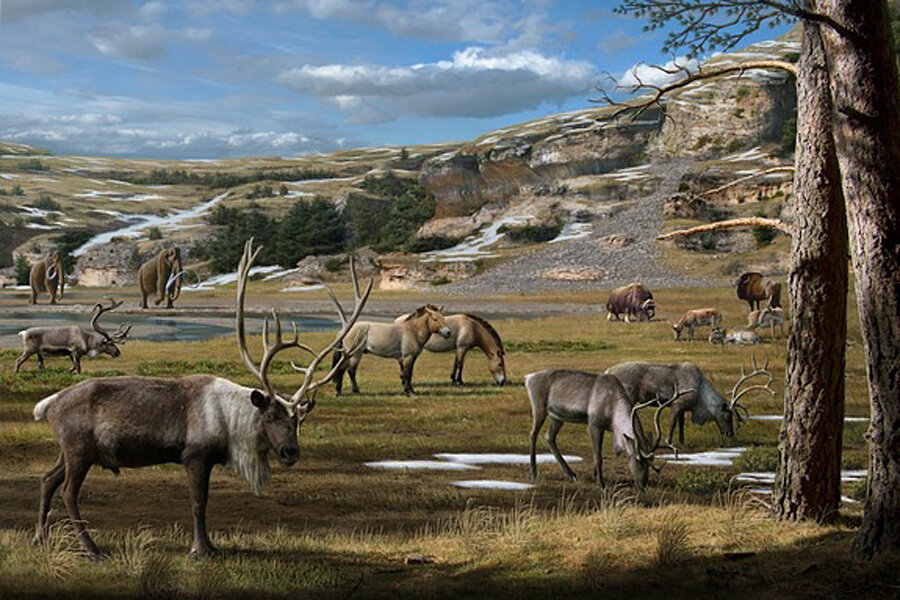Woolly rhinoceroses and woolly mammoths ate forbs, say scientists
Loading...
Woolly mammoths, rhinos and other ice age beasts may have munched on high-protein wildflowers called forbs, new research suggests.
And far from living in a monotonous grassland, the mega-beasts inhabited a colorful Arctic landscape filled with flowering plants and diverse vegetation, the study researchers found.
The new research "paints a different picture of the Arctic," thousands of years ago, said study co-author Joseph Craine, an ecosystem ecologist at Kansas State University. "It makes us rethink how the vegetation looked and how those animals thrived on the landscape."
The ancient ecosystem was detailed today (Feb. 5) in the journal Nature.
Pretty landscape
In the past, scientists imagined that the now-vast Arctic tundra was once a brown grassland steppe that teemed with wooly mammoths, rhinos and bison. But recreations of the ancient Arctic vegetation relied on fossilized pollen found in permafrost, or frozen soil. Because grasses and sedges tend to produce more pollen than other plants, those analyses produced a biased picture of the landscape. [Image Gallery: Ancient Beasts Roam an Arctic Landscape]
To understand the ancient landscape better, researchers analyzed the plant genetic material found in 242 samples of permafrost from across Siberia, Northern Europe and Alaska that dated as far back as 50,000 years ago.
They also analyzed the DNA found in the gut contents and fossilized poop, or coprolites, of eight Pleistocene beasts — woolly mammoths, rhinos, bison and horses — found in museums throughout the world.
The DNA analysis showed that the Arctic at the time had a varied landscape filled with wildflowers, grasses and other vegetation.
And the shaggy ice age beasts that roamed the landscape took advantage of that cornucopia. The grazers supplemented their grassy diet with a hefty helping of wildflowerlike plants known as forbs, the stomach content analysis found.
These forbs are high in protein and other nutrients, which may have helped the grazers put on weight and reproduce in the otherwise sparse Arctic environment, Craine told Live Science.
Vanishing wildflowers
Between 10,000 and 15,000 years ago, forbs declined in the Arctic, study co-author Mary E. Edwards, a physical geographer at the University of Southampton in England, wrote in an email.
Though it's not exactly clear why, "we do know from much other evidence that the climate changed at this time," Edwards said.
The ice age was ending and warmer, wetter weather was prevailing. That climate "allowed trees and shrubs to flourish and these would have outgrown forbs — by shading them for example," Edwards said.
It's also possible that the vanishing of these high-protein plants hastened the extinction of ice age beasts such as the woolly mammoth. For example, grasslands may have been delicately balanced, with poop from the grazers nourishing the plants, which in turn kept the animals alive. If a big jolt in climate disrupted one part of the chain — for instance by depleting the forbs — that may have led the whole system to collapse, Edwards speculated.
The findings also raise questions about modern grazers such as bison, Craine said. If the ancient beasts dined on forbs, it's possible these wildflowerlike plants play a bigger role in the diet of modern bison as well, he said.
Follow Tia Ghose on Twitter and Google+. Follow Live Science @livescience, Facebook & Google+. Original article on Live Science.
- Image Gallery: 25 Amazing Ancient Beasts
- Image Gallery: Fossil Forest in the Canadian Arctic
- 6 Extinct Animals That Could Be Brought Back to Life
Copyright 2014 LiveScience, a TechMediaNetwork company. All rights reserved. This material may not be published, broadcast, rewritten or redistributed.







